Analysis of Budget Cuts on Higher Education Funding in Australia
VerifiedAdded on 2020/03/07
|7
|1510
|67
Report
AI Summary
This report examines the proposed budget cuts to higher education funding in Australia, focusing on the 2017 budget's proposal to slash university funding. It analyzes the potential consequences of these cuts, including increased student fees, changes to HECS loans, and the impact on international student enrollment. The report explores the arguments for and against the reforms, considering the perspectives of various stakeholders such as the Labor party, university administrators, and international education experts. It highlights the potential negative impacts on the quality of education, the competitiveness of Australian universities, and the overall economy, while also acknowledging the government's perspective on fiscal sustainability. The report concludes with recommendations for the government, emphasizing the need to preserve the education export industry and reconsider the proposed funding cuts to ensure Australia's competitive edge in the global education market. The report also includes an analysis of enrollment rates and relevant data from internationaleducation.gov.au, and a detailed bibliography of the sources used to inform the research.

Running Head: Higher Education Reforms
Budget Cuts on Higher Education Funding
By (Name)
(Tutor)
(University)
(Date)
Budget Cuts on Higher Education Funding
By (Name)
(Tutor)
(University)
(Date)
Paraphrase This Document
Need a fresh take? Get an instant paraphrase of this document with our AI Paraphraser
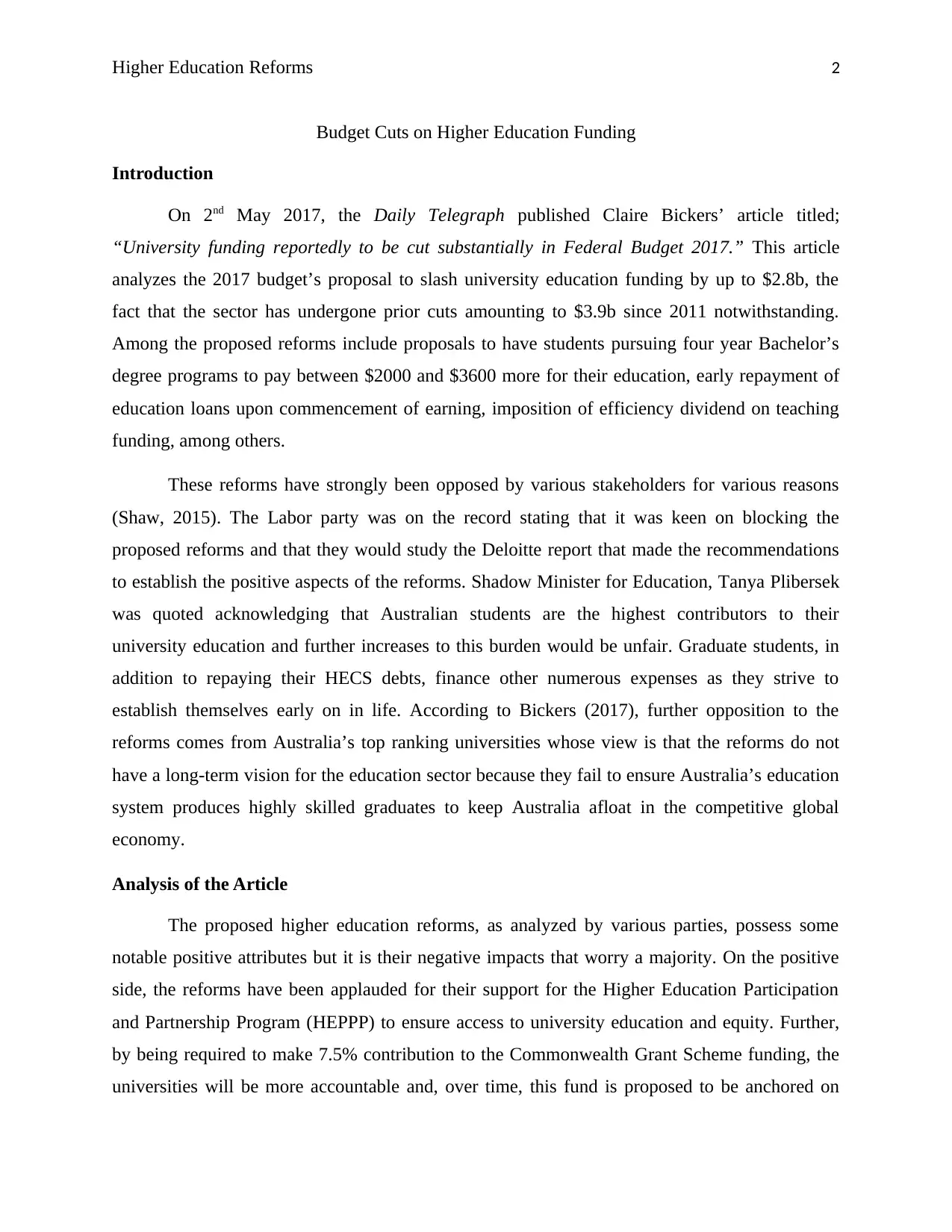
Higher Education Reforms 2
Budget Cuts on Higher Education Funding
Introduction
On 2nd May 2017, the Daily Telegraph published Claire Bickers’ article titled;
“University funding reportedly to be cut substantially in Federal Budget 2017.” This article
analyzes the 2017 budget’s proposal to slash university education funding by up to $2.8b, the
fact that the sector has undergone prior cuts amounting to $3.9b since 2011 notwithstanding.
Among the proposed reforms include proposals to have students pursuing four year Bachelor’s
degree programs to pay between $2000 and $3600 more for their education, early repayment of
education loans upon commencement of earning, imposition of efficiency dividend on teaching
funding, among others.
These reforms have strongly been opposed by various stakeholders for various reasons
(Shaw, 2015). The Labor party was on the record stating that it was keen on blocking the
proposed reforms and that they would study the Deloitte report that made the recommendations
to establish the positive aspects of the reforms. Shadow Minister for Education, Tanya Plibersek
was quoted acknowledging that Australian students are the highest contributors to their
university education and further increases to this burden would be unfair. Graduate students, in
addition to repaying their HECS debts, finance other numerous expenses as they strive to
establish themselves early on in life. According to Bickers (2017), further opposition to the
reforms comes from Australia’s top ranking universities whose view is that the reforms do not
have a long-term vision for the education sector because they fail to ensure Australia’s education
system produces highly skilled graduates to keep Australia afloat in the competitive global
economy.
Analysis of the Article
The proposed higher education reforms, as analyzed by various parties, possess some
notable positive attributes but it is their negative impacts that worry a majority. On the positive
side, the reforms have been applauded for their support for the Higher Education Participation
and Partnership Program (HEPPP) to ensure access to university education and equity. Further,
by being required to make 7.5% contribution to the Commonwealth Grant Scheme funding, the
universities will be more accountable and, over time, this fund is proposed to be anchored on
Budget Cuts on Higher Education Funding
Introduction
On 2nd May 2017, the Daily Telegraph published Claire Bickers’ article titled;
“University funding reportedly to be cut substantially in Federal Budget 2017.” This article
analyzes the 2017 budget’s proposal to slash university education funding by up to $2.8b, the
fact that the sector has undergone prior cuts amounting to $3.9b since 2011 notwithstanding.
Among the proposed reforms include proposals to have students pursuing four year Bachelor’s
degree programs to pay between $2000 and $3600 more for their education, early repayment of
education loans upon commencement of earning, imposition of efficiency dividend on teaching
funding, among others.
These reforms have strongly been opposed by various stakeholders for various reasons
(Shaw, 2015). The Labor party was on the record stating that it was keen on blocking the
proposed reforms and that they would study the Deloitte report that made the recommendations
to establish the positive aspects of the reforms. Shadow Minister for Education, Tanya Plibersek
was quoted acknowledging that Australian students are the highest contributors to their
university education and further increases to this burden would be unfair. Graduate students, in
addition to repaying their HECS debts, finance other numerous expenses as they strive to
establish themselves early on in life. According to Bickers (2017), further opposition to the
reforms comes from Australia’s top ranking universities whose view is that the reforms do not
have a long-term vision for the education sector because they fail to ensure Australia’s education
system produces highly skilled graduates to keep Australia afloat in the competitive global
economy.
Analysis of the Article
The proposed higher education reforms, as analyzed by various parties, possess some
notable positive attributes but it is their negative impacts that worry a majority. On the positive
side, the reforms have been applauded for their support for the Higher Education Participation
and Partnership Program (HEPPP) to ensure access to university education and equity. Further,
by being required to make 7.5% contribution to the Commonwealth Grant Scheme funding, the
universities will be more accountable and, over time, this fund is proposed to be anchored on
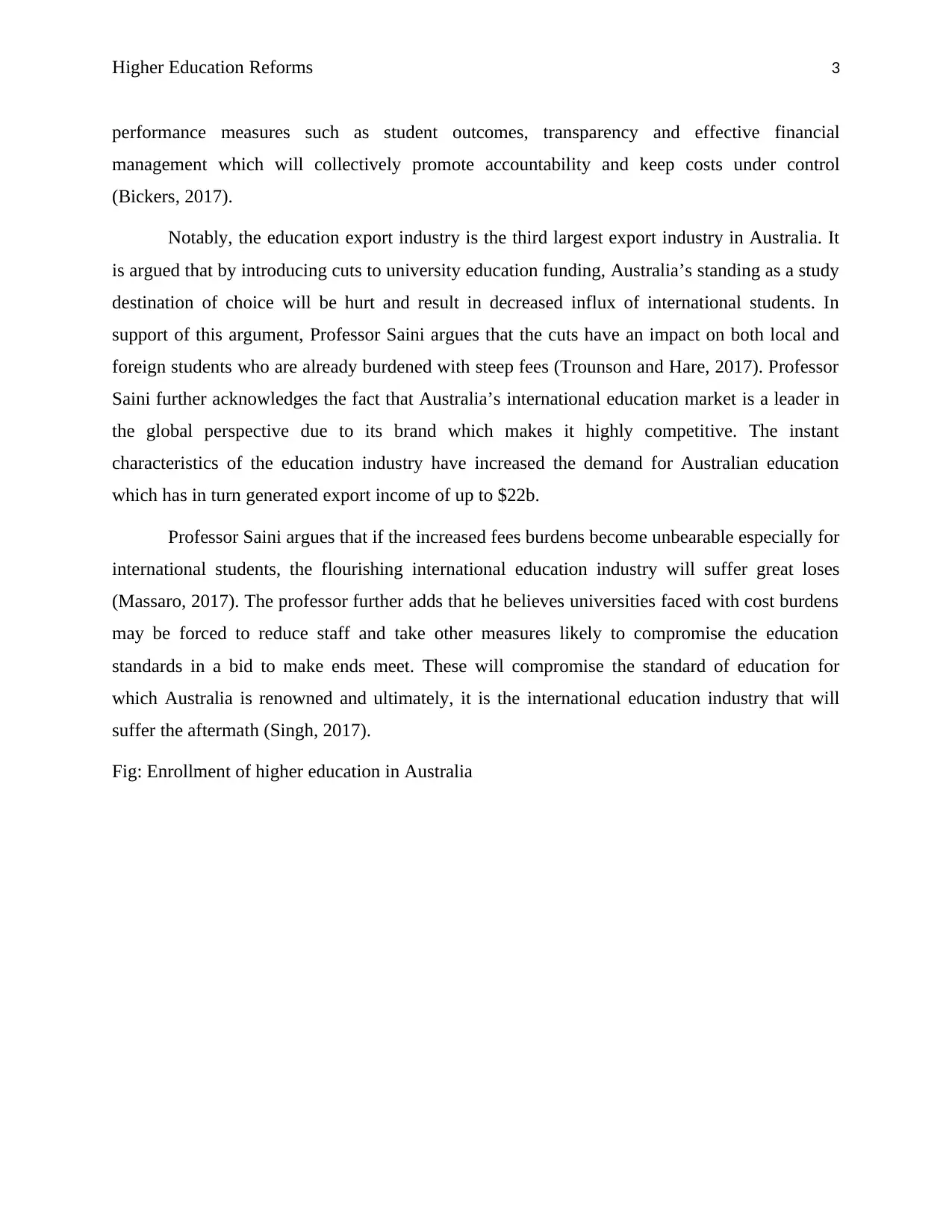
Higher Education Reforms 3
performance measures such as student outcomes, transparency and effective financial
management which will collectively promote accountability and keep costs under control
(Bickers, 2017).
Notably, the education export industry is the third largest export industry in Australia. It
is argued that by introducing cuts to university education funding, Australia’s standing as a study
destination of choice will be hurt and result in decreased influx of international students. In
support of this argument, Professor Saini argues that the cuts have an impact on both local and
foreign students who are already burdened with steep fees (Trounson and Hare, 2017). Professor
Saini further acknowledges the fact that Australia’s international education market is a leader in
the global perspective due to its brand which makes it highly competitive. The instant
characteristics of the education industry have increased the demand for Australian education
which has in turn generated export income of up to $22b.
Professor Saini argues that if the increased fees burdens become unbearable especially for
international students, the flourishing international education industry will suffer great loses
(Massaro, 2017). The professor further adds that he believes universities faced with cost burdens
may be forced to reduce staff and take other measures likely to compromise the education
standards in a bid to make ends meet. These will compromise the standard of education for
which Australia is renowned and ultimately, it is the international education industry that will
suffer the aftermath (Singh, 2017).
Fig: Enrollment of higher education in Australia
performance measures such as student outcomes, transparency and effective financial
management which will collectively promote accountability and keep costs under control
(Bickers, 2017).
Notably, the education export industry is the third largest export industry in Australia. It
is argued that by introducing cuts to university education funding, Australia’s standing as a study
destination of choice will be hurt and result in decreased influx of international students. In
support of this argument, Professor Saini argues that the cuts have an impact on both local and
foreign students who are already burdened with steep fees (Trounson and Hare, 2017). Professor
Saini further acknowledges the fact that Australia’s international education market is a leader in
the global perspective due to its brand which makes it highly competitive. The instant
characteristics of the education industry have increased the demand for Australian education
which has in turn generated export income of up to $22b.
Professor Saini argues that if the increased fees burdens become unbearable especially for
international students, the flourishing international education industry will suffer great loses
(Massaro, 2017). The professor further adds that he believes universities faced with cost burdens
may be forced to reduce staff and take other measures likely to compromise the education
standards in a bid to make ends meet. These will compromise the standard of education for
which Australia is renowned and ultimately, it is the international education industry that will
suffer the aftermath (Singh, 2017).
Fig: Enrollment of higher education in Australia
⊘ This is a preview!⊘
Do you want full access?
Subscribe today to unlock all pages.

Trusted by 1+ million students worldwide
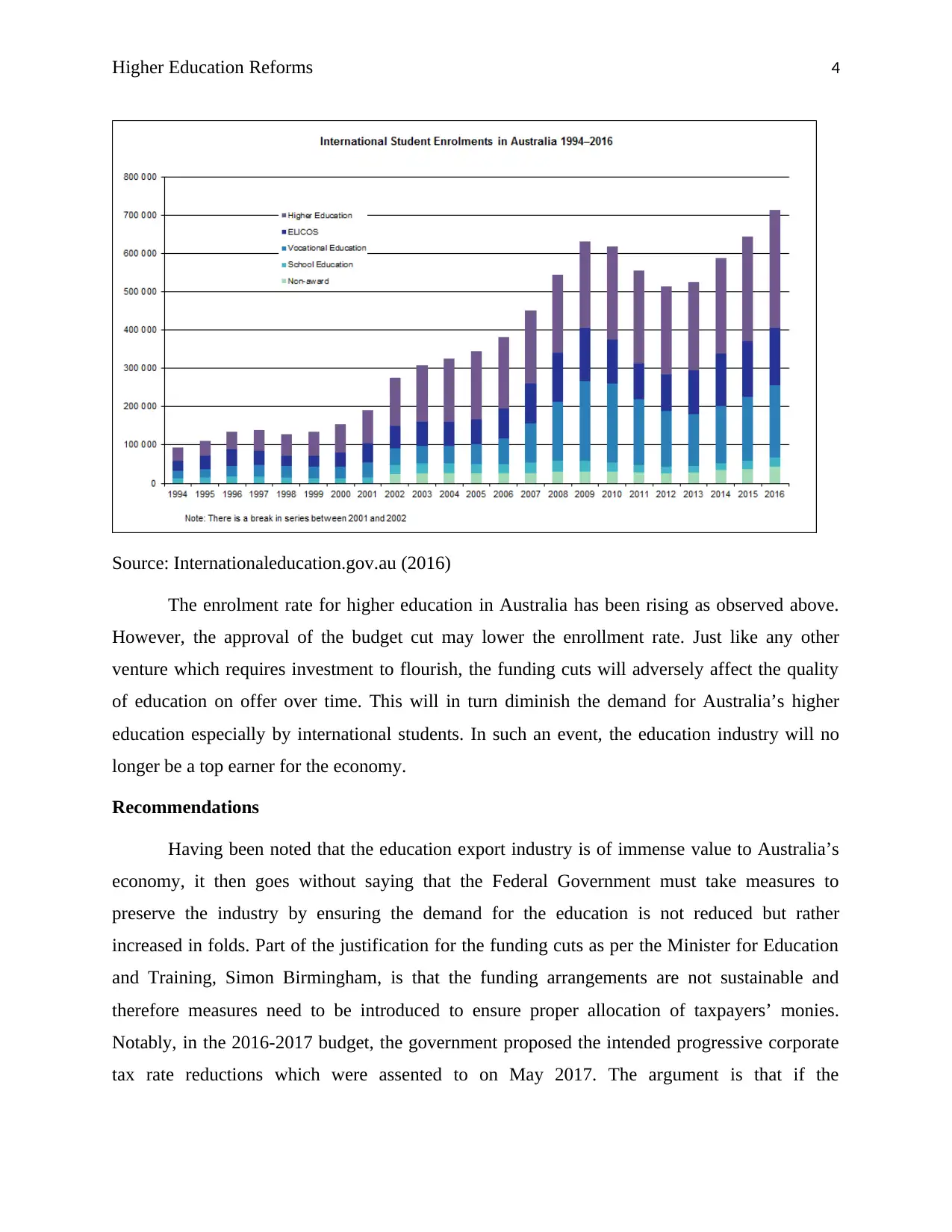
Higher Education Reforms 4
Source: Internationaleducation.gov.au (2016)
The enrolment rate for higher education in Australia has been rising as observed above.
However, the approval of the budget cut may lower the enrollment rate. Just like any other
venture which requires investment to flourish, the funding cuts will adversely affect the quality
of education on offer over time. This will in turn diminish the demand for Australia’s higher
education especially by international students. In such an event, the education industry will no
longer be a top earner for the economy.
Recommendations
Having been noted that the education export industry is of immense value to Australia’s
economy, it then goes without saying that the Federal Government must take measures to
preserve the industry by ensuring the demand for the education is not reduced but rather
increased in folds. Part of the justification for the funding cuts as per the Minister for Education
and Training, Simon Birmingham, is that the funding arrangements are not sustainable and
therefore measures need to be introduced to ensure proper allocation of taxpayers’ monies.
Notably, in the 2016-2017 budget, the government proposed the intended progressive corporate
tax rate reductions which were assented to on May 2017. The argument is that if the
Source: Internationaleducation.gov.au (2016)
The enrolment rate for higher education in Australia has been rising as observed above.
However, the approval of the budget cut may lower the enrollment rate. Just like any other
venture which requires investment to flourish, the funding cuts will adversely affect the quality
of education on offer over time. This will in turn diminish the demand for Australia’s higher
education especially by international students. In such an event, the education industry will no
longer be a top earner for the economy.
Recommendations
Having been noted that the education export industry is of immense value to Australia’s
economy, it then goes without saying that the Federal Government must take measures to
preserve the industry by ensuring the demand for the education is not reduced but rather
increased in folds. Part of the justification for the funding cuts as per the Minister for Education
and Training, Simon Birmingham, is that the funding arrangements are not sustainable and
therefore measures need to be introduced to ensure proper allocation of taxpayers’ monies.
Notably, in the 2016-2017 budget, the government proposed the intended progressive corporate
tax rate reductions which were assented to on May 2017. The argument is that if the
Paraphrase This Document
Need a fresh take? Get an instant paraphrase of this document with our AI Paraphraser

Higher Education Reforms 5
government’s objective is to find money in the budget, paramount consideration should not be to
overburden students with more fees while reducing corporate tax rates.
Another troubling aspect of the 2017 budget proposal is the requirement to have students
pay interest on the HECS loans. This move and the fact that there will be increased fees is
tantamount to transferring costs to students and it will undoubtedly be a disadvantage to the
students, more so those from poor backgrounds. Instead of adopting this policy, the best
approach would be for the government to allow students to begin making payments only after
graduating and when they begin to earn income that is above the repayment threshold.
Conclusion
In sum, the Federal Government needs to keep in mind the fact that universities compete
globally. Therefore, reform policies must be streamlined to ensure Australia’s competitive edge
is maintained. There appears to be a clear disconnect between the proposed education funding
cuts and the need to produce highly skilled graduates, job creation through research and
increasing of productivity within the education industry. It is arguable that the government has
its priorities misplaced by advocating for business tax cuts while at the same time cutting
university funding. While it is agreeable that business tax cuts allow Australia to market itself as
a globally competitive economy for investors to set up shop, the same argument can be applied
to the universities which are Australia’s third largest export. It is therefore necessary that the
government should reconsider the proposed funding cuts.
government’s objective is to find money in the budget, paramount consideration should not be to
overburden students with more fees while reducing corporate tax rates.
Another troubling aspect of the 2017 budget proposal is the requirement to have students
pay interest on the HECS loans. This move and the fact that there will be increased fees is
tantamount to transferring costs to students and it will undoubtedly be a disadvantage to the
students, more so those from poor backgrounds. Instead of adopting this policy, the best
approach would be for the government to allow students to begin making payments only after
graduating and when they begin to earn income that is above the repayment threshold.
Conclusion
In sum, the Federal Government needs to keep in mind the fact that universities compete
globally. Therefore, reform policies must be streamlined to ensure Australia’s competitive edge
is maintained. There appears to be a clear disconnect between the proposed education funding
cuts and the need to produce highly skilled graduates, job creation through research and
increasing of productivity within the education industry. It is arguable that the government has
its priorities misplaced by advocating for business tax cuts while at the same time cutting
university funding. While it is agreeable that business tax cuts allow Australia to market itself as
a globally competitive economy for investors to set up shop, the same argument can be applied
to the universities which are Australia’s third largest export. It is therefore necessary that the
government should reconsider the proposed funding cuts.
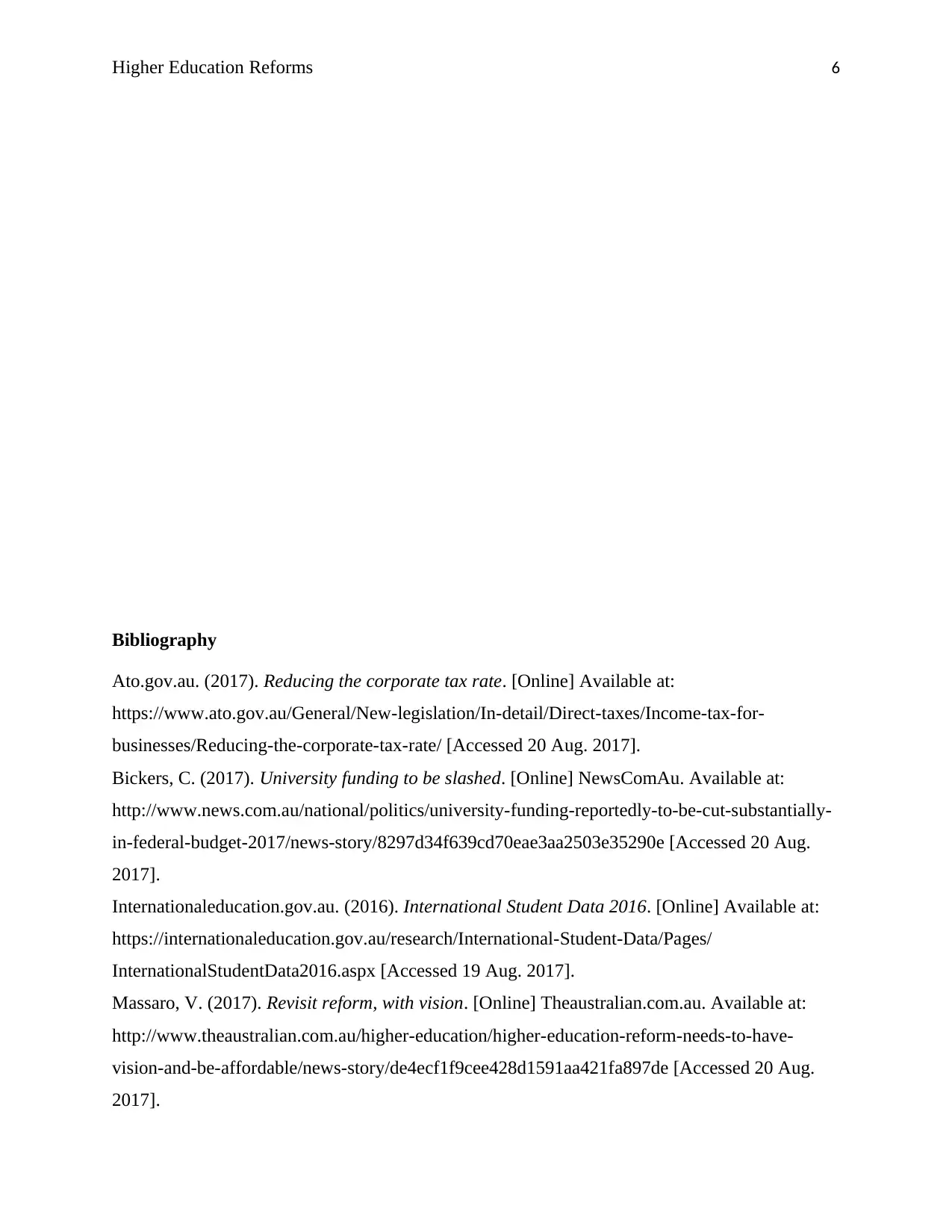
Higher Education Reforms 6
Bibliography
Ato.gov.au. (2017). Reducing the corporate tax rate. [Online] Available at:
https://www.ato.gov.au/General/New-legislation/In-detail/Direct-taxes/Income-tax-for-
businesses/Reducing-the-corporate-tax-rate/ [Accessed 20 Aug. 2017].
Bickers, C. (2017). University funding to be slashed. [Online] NewsComAu. Available at:
http://www.news.com.au/national/politics/university-funding-reportedly-to-be-cut-substantially-
in-federal-budget-2017/news-story/8297d34f639cd70eae3aa2503e35290e [Accessed 20 Aug.
2017].
Internationaleducation.gov.au. (2016). International Student Data 2016. [Online] Available at:
https://internationaleducation.gov.au/research/International-Student-Data/Pages/
InternationalStudentData2016.aspx [Accessed 19 Aug. 2017].
Massaro, V. (2017). Revisit reform, with vision. [Online] Theaustralian.com.au. Available at:
http://www.theaustralian.com.au/higher-education/higher-education-reform-needs-to-have-
vision-and-be-affordable/news-story/de4ecf1f9cee428d1591aa421fa897de [Accessed 20 Aug.
2017].
Bibliography
Ato.gov.au. (2017). Reducing the corporate tax rate. [Online] Available at:
https://www.ato.gov.au/General/New-legislation/In-detail/Direct-taxes/Income-tax-for-
businesses/Reducing-the-corporate-tax-rate/ [Accessed 20 Aug. 2017].
Bickers, C. (2017). University funding to be slashed. [Online] NewsComAu. Available at:
http://www.news.com.au/national/politics/university-funding-reportedly-to-be-cut-substantially-
in-federal-budget-2017/news-story/8297d34f639cd70eae3aa2503e35290e [Accessed 20 Aug.
2017].
Internationaleducation.gov.au. (2016). International Student Data 2016. [Online] Available at:
https://internationaleducation.gov.au/research/International-Student-Data/Pages/
InternationalStudentData2016.aspx [Accessed 19 Aug. 2017].
Massaro, V. (2017). Revisit reform, with vision. [Online] Theaustralian.com.au. Available at:
http://www.theaustralian.com.au/higher-education/higher-education-reform-needs-to-have-
vision-and-be-affordable/news-story/de4ecf1f9cee428d1591aa421fa897de [Accessed 20 Aug.
2017].
⊘ This is a preview!⊘
Do you want full access?
Subscribe today to unlock all pages.

Trusted by 1+ million students worldwide
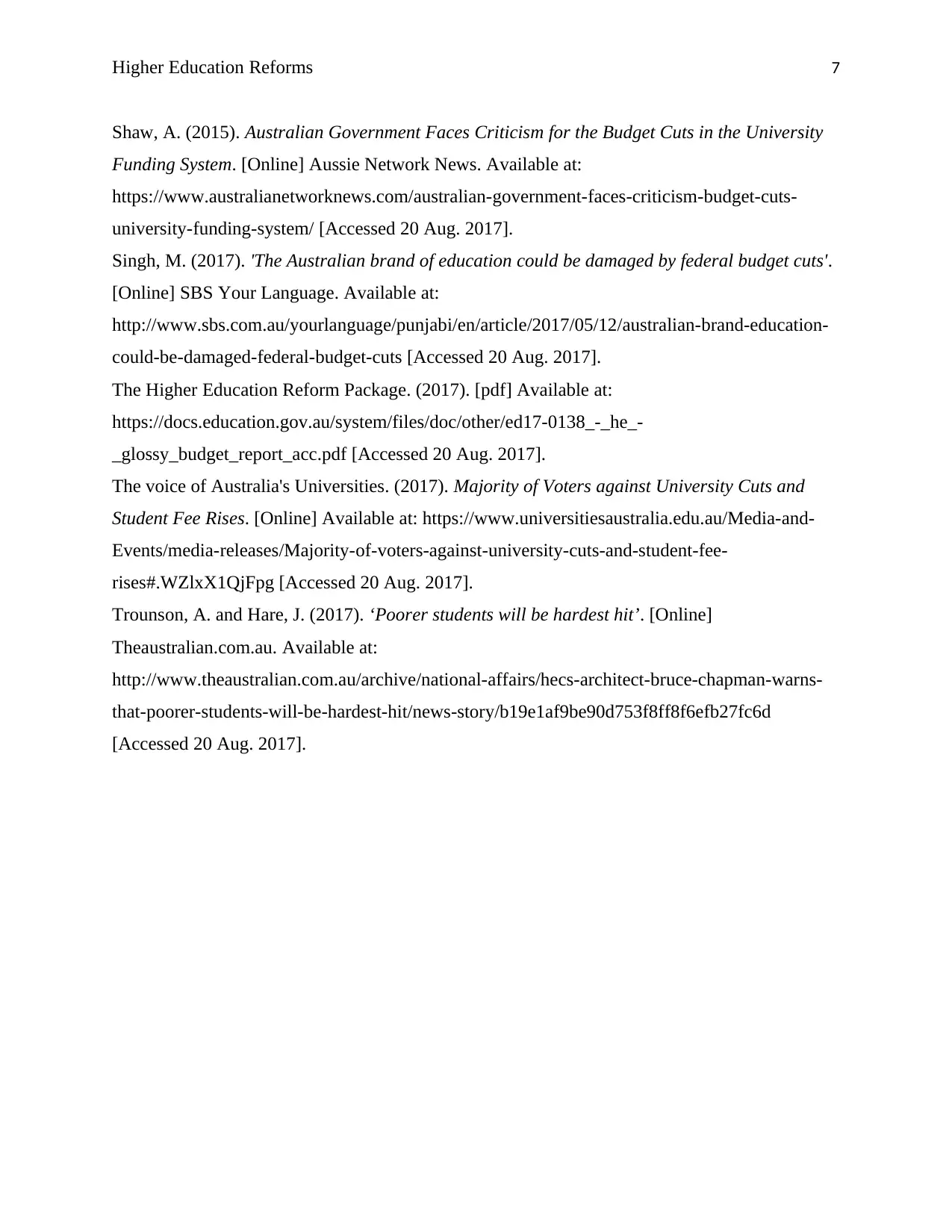
Higher Education Reforms 7
Shaw, A. (2015). Australian Government Faces Criticism for the Budget Cuts in the University
Funding System. [Online] Aussie Network News. Available at:
https://www.australianetworknews.com/australian-government-faces-criticism-budget-cuts-
university-funding-system/ [Accessed 20 Aug. 2017].
Singh, M. (2017). 'The Australian brand of education could be damaged by federal budget cuts'.
[Online] SBS Your Language. Available at:
http://www.sbs.com.au/yourlanguage/punjabi/en/article/2017/05/12/australian-brand-education-
could-be-damaged-federal-budget-cuts [Accessed 20 Aug. 2017].
The Higher Education Reform Package. (2017). [pdf] Available at:
https://docs.education.gov.au/system/files/doc/other/ed17-0138_-_he_-
_glossy_budget_report_acc.pdf [Accessed 20 Aug. 2017].
The voice of Australia's Universities. (2017). Majority of Voters against University Cuts and
Student Fee Rises. [Online] Available at: https://www.universitiesaustralia.edu.au/Media-and-
Events/media-releases/Majority-of-voters-against-university-cuts-and-student-fee-
rises#.WZlxX1QjFpg [Accessed 20 Aug. 2017].
Trounson, A. and Hare, J. (2017). ‘Poorer students will be hardest hit’. [Online]
Theaustralian.com.au. Available at:
http://www.theaustralian.com.au/archive/national-affairs/hecs-architect-bruce-chapman-warns-
that-poorer-students-will-be-hardest-hit/news-story/b19e1af9be90d753f8ff8f6efb27fc6d
[Accessed 20 Aug. 2017].
Shaw, A. (2015). Australian Government Faces Criticism for the Budget Cuts in the University
Funding System. [Online] Aussie Network News. Available at:
https://www.australianetworknews.com/australian-government-faces-criticism-budget-cuts-
university-funding-system/ [Accessed 20 Aug. 2017].
Singh, M. (2017). 'The Australian brand of education could be damaged by federal budget cuts'.
[Online] SBS Your Language. Available at:
http://www.sbs.com.au/yourlanguage/punjabi/en/article/2017/05/12/australian-brand-education-
could-be-damaged-federal-budget-cuts [Accessed 20 Aug. 2017].
The Higher Education Reform Package. (2017). [pdf] Available at:
https://docs.education.gov.au/system/files/doc/other/ed17-0138_-_he_-
_glossy_budget_report_acc.pdf [Accessed 20 Aug. 2017].
The voice of Australia's Universities. (2017). Majority of Voters against University Cuts and
Student Fee Rises. [Online] Available at: https://www.universitiesaustralia.edu.au/Media-and-
Events/media-releases/Majority-of-voters-against-university-cuts-and-student-fee-
rises#.WZlxX1QjFpg [Accessed 20 Aug. 2017].
Trounson, A. and Hare, J. (2017). ‘Poorer students will be hardest hit’. [Online]
Theaustralian.com.au. Available at:
http://www.theaustralian.com.au/archive/national-affairs/hecs-architect-bruce-chapman-warns-
that-poorer-students-will-be-hardest-hit/news-story/b19e1af9be90d753f8ff8f6efb27fc6d
[Accessed 20 Aug. 2017].
1 out of 7
Related Documents
Your All-in-One AI-Powered Toolkit for Academic Success.
+13062052269
info@desklib.com
Available 24*7 on WhatsApp / Email
![[object Object]](/_next/static/media/star-bottom.7253800d.svg)
Unlock your academic potential
Copyright © 2020–2025 A2Z Services. All Rights Reserved. Developed and managed by ZUCOL.





